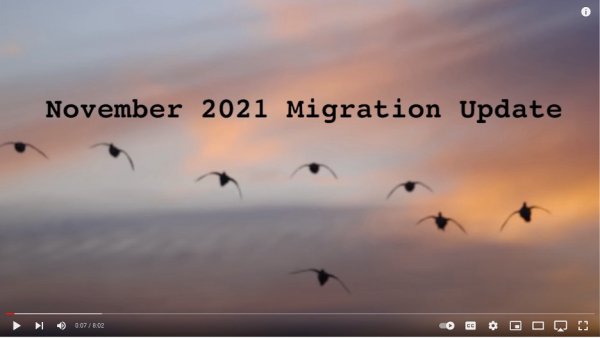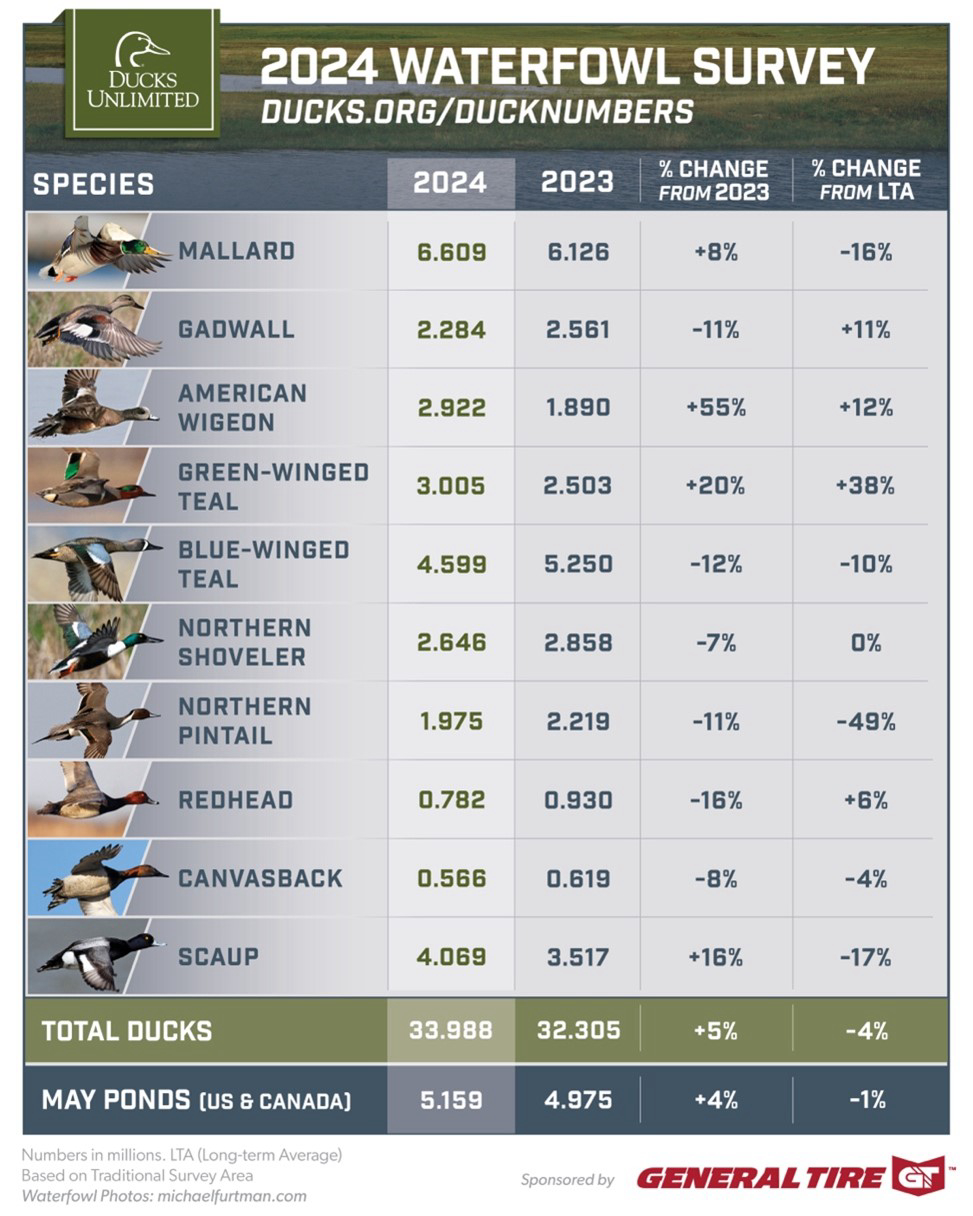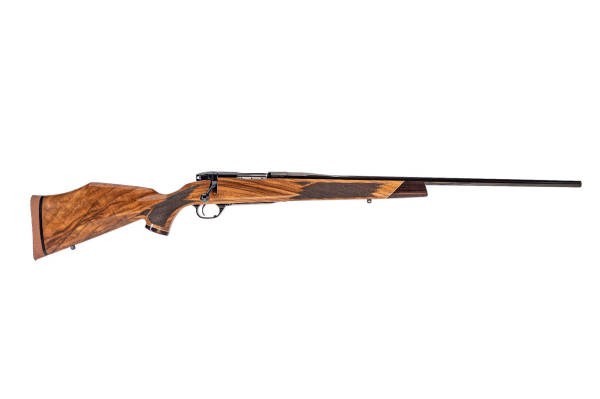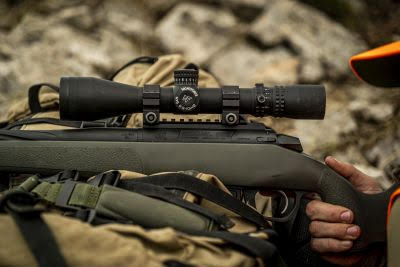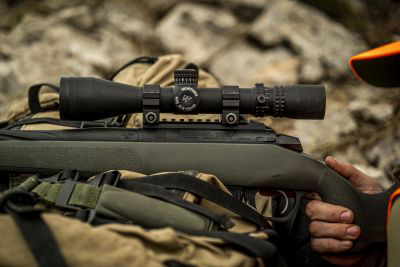Weatherby of the North
Hunting Waterfowl in Saskatchewan
By Jay Pinsky – Editor, The Hunting Wire
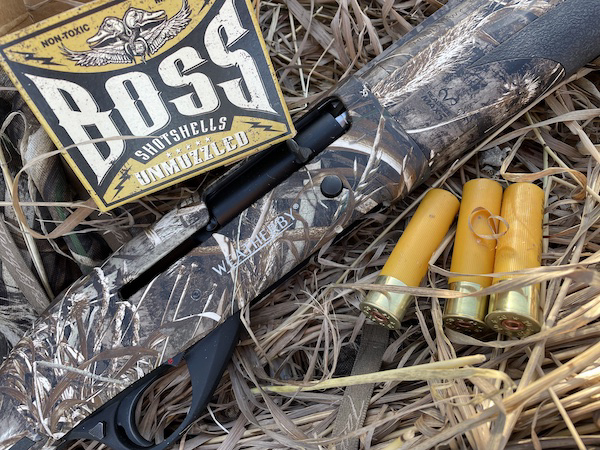
Waterfowl hunting isn’t for the faint of heart. Bitterly cold temperatures, low, gray skies, and strong winds which ruin most hunts put smiles on most waterfowlers faces, who know success often comes long after most fair-weather hunters call it quits. As such, waterfowl hunters, at least the ones who do it a second time, pride themselves on being a hearty lot. They demand a lot of themselves, their hunting dogs, and their equipment not just for a single experience, but as a lifetime.
That said, waterfowlers need guns which don’t just look tough, but genuinely are tough. Not just for one day, or for one shot-of-a-lifetime moment. No, waterfowl hunting guns must work every day, in the worst weather, frozen, with gloves on, in the dark of blinds, by feel, with heavy loads and under all kinds of shooting situations. After all, there’s not a lot of waterfowl hunting at a sporting clay course these days. Waterfowl guns must work while muddy, often filthy on the inside, and if you’re lucky, reeking of wet dog, Canada goose guts, and of course shotgun shell powder. Waterfowl shotguns aren’t expected to be runway models. Nope, they’re as blue-collar as a gun can be which is why the best ones demand white-collar dollars.
Or do they?
If ever there was a blue-collar firearms manufacturer, Weatherby would be it. Family-owned and operated since its creation, today’s Sheridan, Wyoming-based Weatherby is run intimately and efficiently by Adam and Brenda Weatherby and their employees who can and do pass for family at the company BBQ. Historically, Weatherby makes well-priced guns that work. Sure, you can scale up a Weatherby firearm to max out your credit card, but you don’t need to. Now, I didn’t say they build a cheap gun. No. They build an honest gun – which is why no one utters the phrase that a Weatherby is a “good gun for the money.” No, they’re just good.
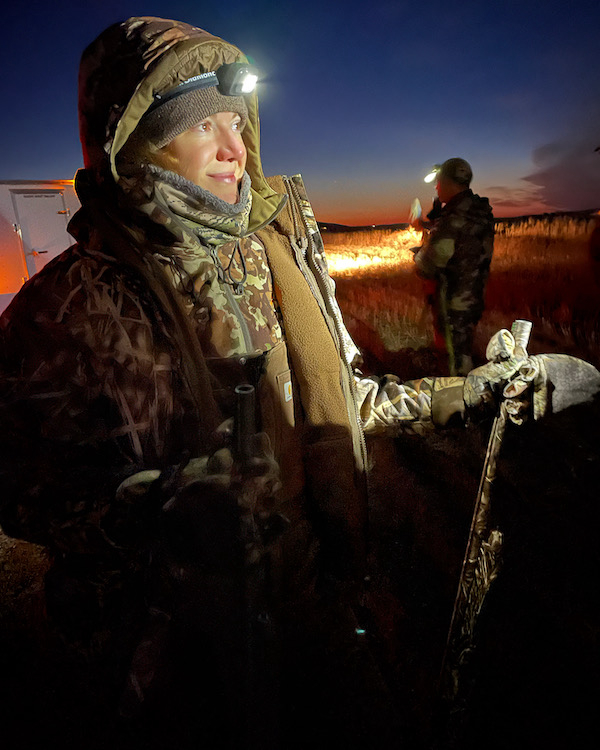
I recently had the opportunity to hunt waterfowl with Weatherby in New Battleford, Saskatchewan, Canada. The Weatherby hunt included several key industry folks from Canada and their dedication to hunting, shooting, and wildlife management was universally the same as ours here in the United States. We hunted with Prairies Edge Outfitting, who operate out of North Battleford, Saskatchewan.
Why Saskatchewan? For Americans it’s a premier hunting location. Says who? Says the experts like Delta Waterfowl’s Vice President of Policy, John Devney. His reasoning? Devney explained it to a novice waterfowler like me in terms just about anyone can understand. Basically, migration is a world-class road trip, and Saskatchewan is the first and one of the best rest stops along their southern route due to the massive agriculture and low Canadian hunting pressure from our northern neighbor. Devney’s logic helped me understand why, even at the tail end of Canada’s season, we encountered hundreds of birds all day long during our three-day hunt.
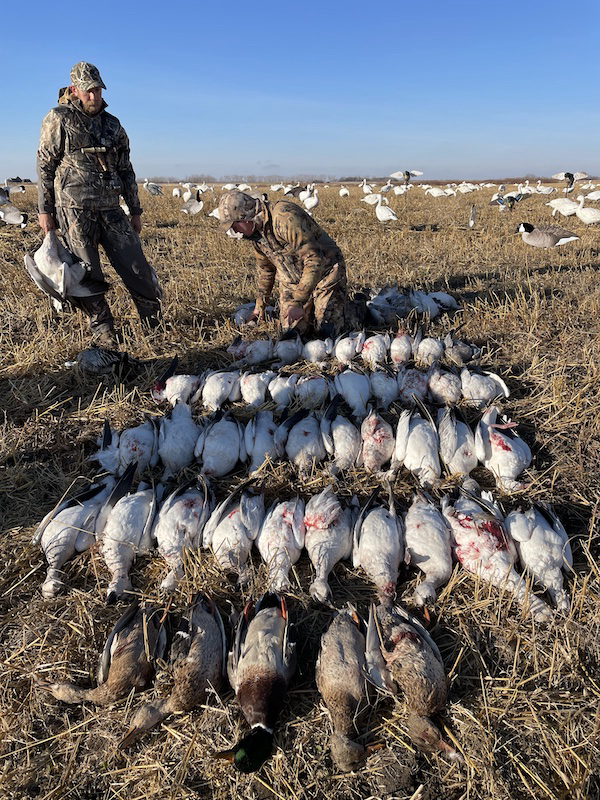
It has been my experience that Delta Waterfowl is a fantastic nonprofit to learn all about waterfowl, their habitat, and hunting. Their Chief Conservation Officer, Joel Bryce, was one of the first volunteers for The Hunting Wire’s Voice of Leadership Panel when it began last year. One of their most useful tools for waterfowl hunters is their Migration Update Series. Here’s the latest one as of publication:
Duck hunting waits for no one. Get the latest updates on duck movements for every flyway. Snow geese and mallards, from the Atlantic to the Pacific, Canada to the Gulf of Mexico, here’s the latest reports from Delta. Enjoy the best of what November hunting has to offer as migrating geese and ducks are filling the sky. Sign up now and get the latest updates delivered right to your inbox. https://dwaterfowl.realmagnet.land/de… Delta Waterfowl | https://deltawaterfowl.org Facebook | https://www.facebook.com/DeltaFans/ Instagram | https://www.instagram.com/deltawaterf… Twitter | https://twitter.com/DeltaWaterfowl/
Back to Canada …
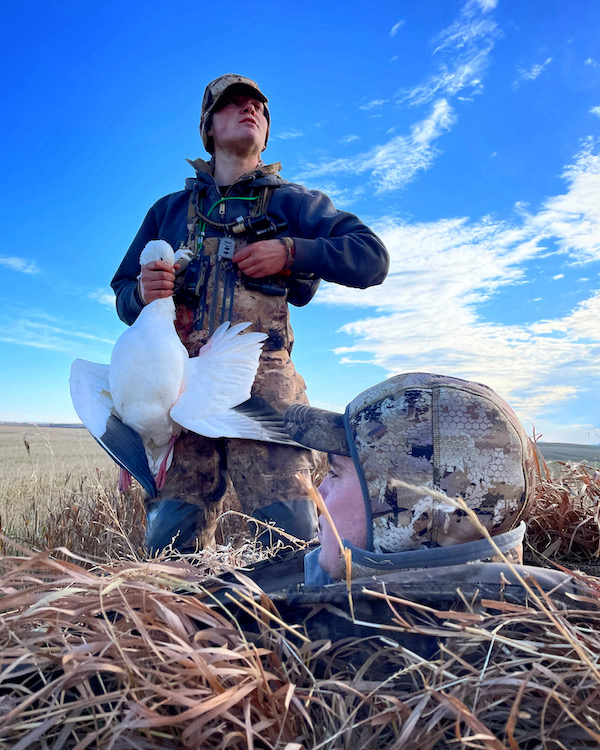
After near two years of border closing, crossing into Canada was refreshing. Sure, there was COVID-19 itself and Canada’s unique rules to deal with to be able to go there. This trip was a choice, and I made the decision to go once Weatherby’s Zach Hein extended the initiation. What do you have to do to hunt Canada? Here are the latest requirements.
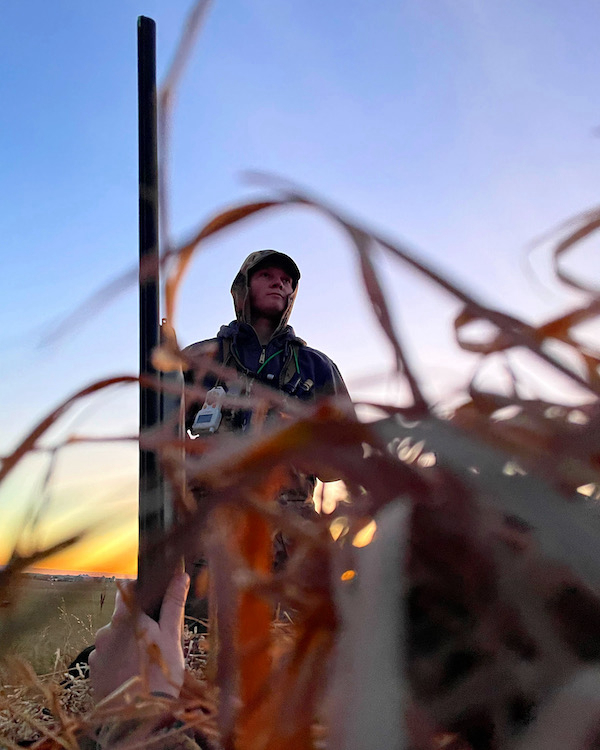
Now, back to waterfowl hunting!
Most folks know Weatherby for the ultra-fast and powerful rifles and cartridges, but they’ve been in the shotgun business since 1967 when Roy Weatherby brought the company’s first over/under to market. Weatherby brought their three newest shotguns to the hunt. We used their Turkish-built (ATA) Element inertia-driven shotguns chambered in 20 gauge, their Italian-built (Breda) 18i inertia-driven shotguns chambered in 12 gauge, and their newly introduced 20-gauge version of their over-and under shotgun, the Orion, which is Turkish-build (ATA) as well. I know some folks seem to think anything built in Turkey is subpar, but I also know a lot of people who used to think Japanese cars were junk. How’d that work out? No, the Turks have been building shotguns for centuries and know exactly what they’re doing. Let’s cut to the chase – if you own a subpar Turkish-built shotgun, it isn’t because the Turks can’t build them right, it’s because whoever spec’d out your gun didn’t’ set very high standards. Weatherby doesn’t do average. And they never have. Now back to the guns.
All three shotguns, regardless of their chamberings, price point or design, killed ducks, Canada geese, and Snow geese every day for three days early in the morning, midday, and all afternoon. We hunted over agriculture in meticulously camouflaged layout blinds with an army of decoys.
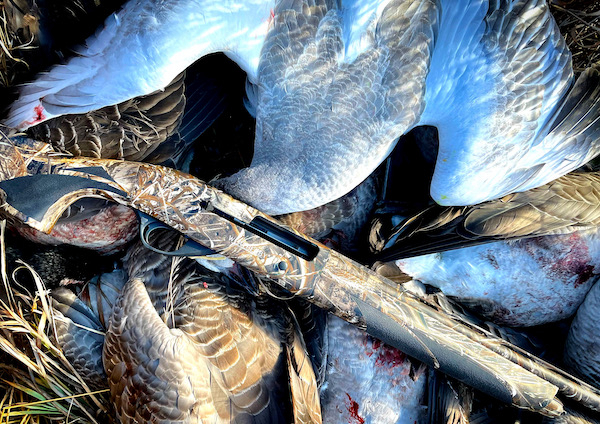
Ammunition-wise, we used a mixture of Boss’s 20 gauge 3-inch Magnum 1 1.8 oz #3/5 lead-free/non-toxic shotgun shells which use copper-plated bismuth, and for the 12 gauges, we used Federal Premium’s Black Cloud® FS Steel® loads. I never had any problems with ammunition not working when I did my part.
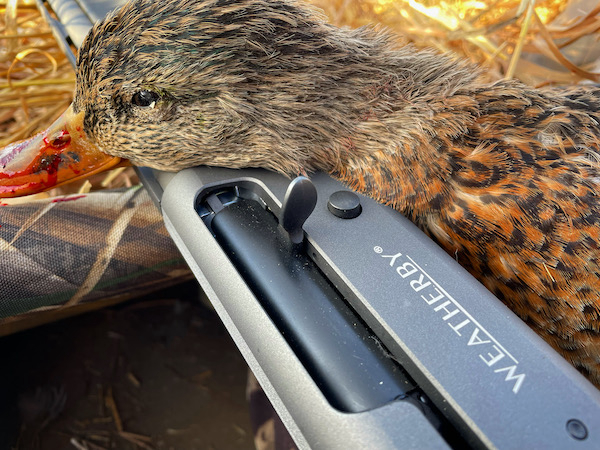
All three guns worked just fine as layout blind shooting tools, including the Orion with the irrational fear of a break-open being clumsy or slow quickly dismissed. In fact, by the end of the hunt the simplicity, and let’s face it, the looks of the 20-gauge Orion won me over as a waterfowl hunter.
Sure the 12 gauge packed a bigger punch, but the Saskatchewan-proven truth was the 20 gauge whether it was an Element or an Orion, hit the ducks and geese plenty hard enough while hitting me a little softer in the shoulder. Another tribute to the Orion is this, like a manually driven car, an over/under shotgun demands its users focus a little more on the mechanics of the firearm.
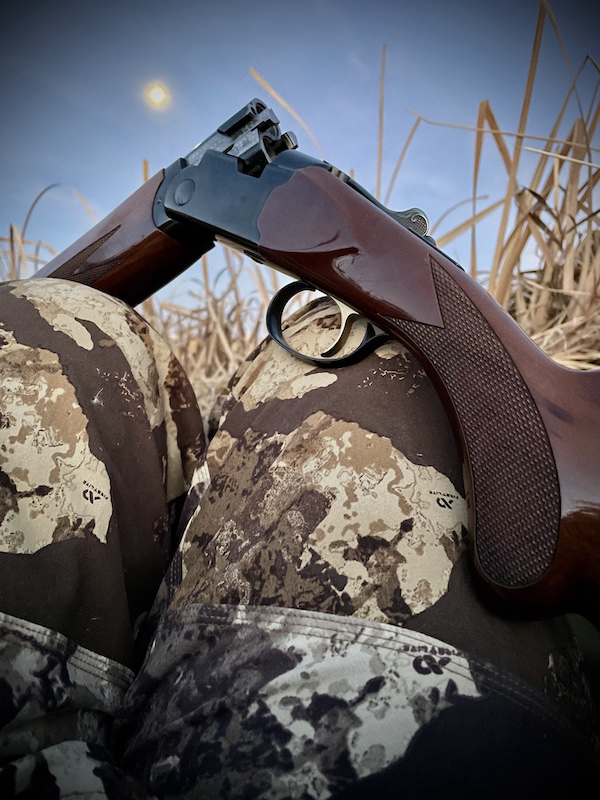
For some it may seem like an unnecessary delay which might cost you a few ducks or geese, and I get that. Me, I enjoy breaking a superlight over/under open every time, reloading it, and shooting birds. It’s as much a part of the hunt to me as seeing birds drop from the sky, or well-trained dogs’ channel their inner FEDEX delivering birds to the blinds on demand. Maybe I’m not a waterfowl hunter at heart. Maybe I’m an upland hunter who occasionally hunts waterfowl. Or maybe, it doesn’t matter. Tack on the fact that over/under shotguns like the Orion clean up easier than a pair of Muck boots, and I see no reason to say no to a break-open boom stick in the waterfowling community.
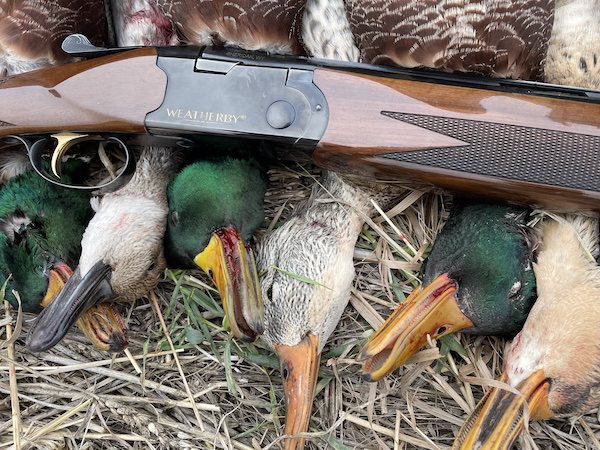
Pragmatically speaking, the Element was the MVP of the hunt to me, I just had goo-goo eyes for the gorgeous Orion. The Element is a bargain in today’s inertia-driven shotgun market, and despite my wandering eye for the Orion, an inexpensive, reliable, and durable semiautomatic shotgun is a beautiful thing. Not once in three days of shooting did an Element jam, misfire, break, misfeed, or call me out (publicly) for missing birds. In the layout blind, the slim stock with a textured grip (Weatherby calls it Griptonite) and positive-click safety gave me gloves-wearing hunting confidence that I could maintain good dexterity with the shotgun for a safe and repeatable shooting cycle as I constantly was up and down on waterfowl from the blind. Add in the fact that you can likely buy a few of them in different camo patterns (think marsh/grasslands/turkey/upland) for the price of just one of the higher-end inertia shotguns on the market today, and it may make your decision easier.
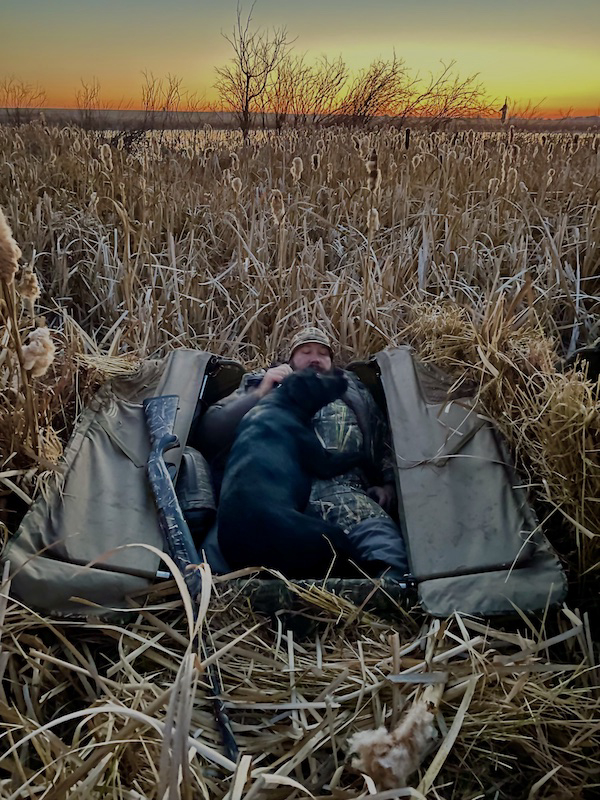
The Element, as of this writing, comes in two chamberings, 12 and 20 gauge, and four flavors. Upland, which is a beautiful wood and metal version (MSRP $749), the Synthetic, which is an all-black, all-utilitarian, low-maintenance shotgun (MSRP $599), the Waterfowler Max-5, which is dressed in Realtree Max-5 camo (MSRP $799), and the ultra-modern looking Element Synthetic Tungsten (MSRP $649) which features a black polymer stock and a tungsten Cerakote barrel and action.
On the last day of the hunt, I rotated into the full-service-priced 18i, which comes mostly in 12 gauge, except the Deluxe which comes in 12 or 20 gauge. In Saskatchewan we had 18i’s flavored in 12 gauge. After two days of shooting 20 gauges, moving up to the 12 was felt and seen immediately both by the birds and me. The ducks and geese weren’t happy. I, however, was.
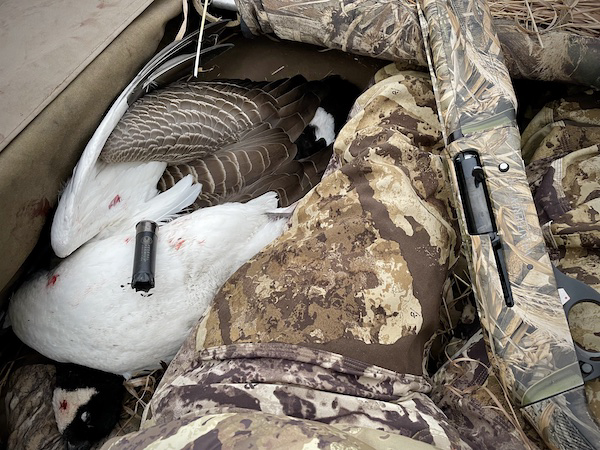
The 18i shotgun is everything a premier shotgun ought to be. Well-built, rugged, reliable, and simple. It’s a bit heavier than an Element, but it’s also a lot beefier too. While I appreciated the build quality, size, and reach of the 18i, its long-armed design didn’t fit me quite as well out of the box as some other shotguns. As such, shouldering it, shooting it, and handling it was more pragmatism than passion. If I were to buy one, I’d resize the stock to my 13-inch length of pull and I’m pretty sure most, if not all, of the fit issues I had with the 18i would be gone. The 12 gauge-chambered 18i’s in three version, Synthetic (MSRP $1149), Waterfowler, which sports a 3.5-inch chamber (MSRP $1239-$1249), and the Deluxe ($1899). Note, 20-gauge fans can get an 18i in the Deluxe.
The short trip to Canada was a success on every level. The guns worked well. The ammo cycled and killed waterfowl when I did my part, and the company was superb. To learn more about Weatherby and their wide range of shotguns visit www.weatherby.com
Want to know more about waterfowl hunting? Delta Waterfowl is keenly dedicated to helping recruit, retain, and reenergize (R3) waterfowl hunters. Learn more here:

